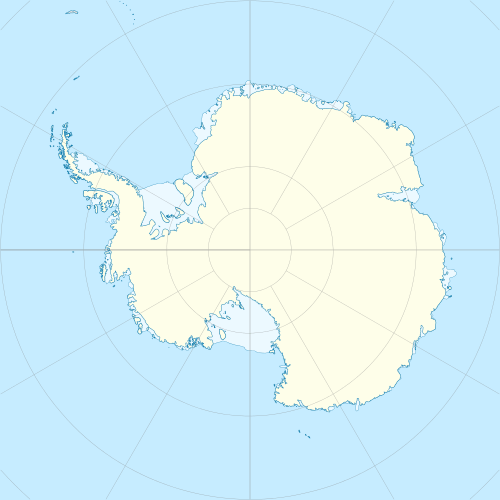King Baudouin Ice Shelf

_(cropped).jpg)
The King Baudouin Ice Shelf (French: Plateforme de glace Roi Baudouin[1]) in Dronning Maud Land, East Antarctica, is within the Norwegian part of Antarctica. It is named after King Baudouin of Belgium (1930-1993).
Geology
The King Baudouin ice shelf is confined by two ice rises (including Derwael Ice Rise) and two under-ice pinning-points with a width of only a few kilometres; the latter seems to define the seaward edge of the ice shelf and impacts ice flow in the hinterland.[2]
Roi Baudoin Base
Belgium was one of the original 12 signatories of the Antarctic Treaty. It established its Roi Baudoin Base scientific research station on the ice shelf in 1958, built for the International Geophysical Year (IGY), and decommissioned in 1967.[3] This operated over several three year cycles: 1958–1961 and 1964–1966.
Study
The ice shelf is being actively studied by Belgian Antarctic Program scientists from the Princess Elisabeth Base. This includes:
- BELARE (Belgian Antarctic Research Project), with a GPS position reference tweeting position and rate of movement, and ice depth measurements;[4]
- Be:Wise, examining the ice dynamics where the shelf is grounded, and which buttress the ice flow from the East Antarctic ice sheet.[2]
Supposed meteor crater
In early 2015, scientists announced the discovery of an almost circular structure in the ice surface, about 2 kilometres (1.2 mi) wide. First hypothesis for its origin, among other ice-shelf processes,[5] was the impact of a meteor.[6] The feature was discovered by German scientist Christian Müller as he conducted an aerial survey on 20 December 2014.[7] If found, this is likely to be the largest, identified, Antarctic meteorite, as the rule of thumb is that the meteorite causing a crater is about 5-10%[8] of the diameter of the crater, or roughly 200m in this case. Initial analysis of satellite images indicates that the feature could have been present before the supposed impact,[9] even for 25 years.[7][8]
References
- ↑ Horizon Recherche newsletter December 2013 Université libre de Bruxelles
- 1 2 Be:Wise -The Buttressing Effect: Why ice shelves are essential, antarcticstation.org, 12 November 2012, accessed 14 January 2015
- ↑ Grand designs: new Antarctic research stations for the IPY, Jean de Pomereu, 28 May 2008, SciencePoles.org, accessed 14 January 2015
- ↑ Researchers Use GPS to Track Antarctica's Ice Migration in Real Time, 14 December 2015, accessed 14 January 2015
- ↑ Seidler, Christoph. "Antarktis: Forscher vermuten großen Meteoriten unterm Eis". SPIEGEL ONLINE.
- ↑ A Curious Antarctic Ring - Could a newly spotted mile-wide impression be a meteorite impact?, Jim Festante, Slate.org, 13 January 2015
- 1 2 Mysterious ring in Antarctica may have been caused by a meteorite, Cheryl Santa Maria, Weather Network, 12 January 2015, accessed 14 January 2015
- 1 2 Two km wide crater in Antarctica linked to 2004 meteorite impact, Jayalakshmi K, International Business Times, 11 January 2015, accessed 14 January 2015
- ↑ Seidler, Christoph. "Antarktis: Forscher vermuten großen Meteoriten unterm Eisd". SPIEGEL ONLINE.
Coordinates: 70°26′S 24°19′E / 70.433°S 24.317°E